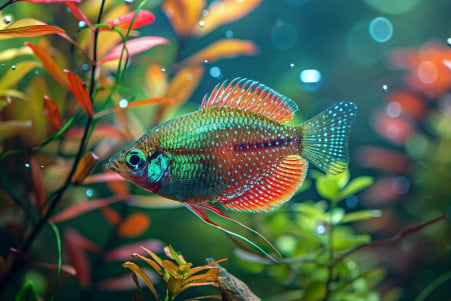Is Tilapia a Bottom Feeder? Exploring Its Feeding Habits
24 March 2024 • Updated 23 March 2024

If you’ve ever asked yourself, “Is tilapia a bottom feeder?” you’re not alone. Many people who enjoy eating this popular fish have wondered about its dietary habits. The short answer is that yes, tilapia is a bottom feeder.
But let’s take a closer look at the research and other information to find out exactly what that means. This will help you make more informed choices when you’re shopping for seafood and give you a better understanding of the potential environmental consequences of tilapia aquaculture. So let’s take a deep dive into the facts.
Is tilapia a bottom feeder?
Nutritional Profile: Nutrients and Risks of Tilapia
Tilapia is a lean source of protein that is also packed with nutrients like selenium, phosphorus, vitamin D, and potassium. According to Healthline, a 3.5 ounce (100g) serving contains 26g of protein and is an excellent source of selenium at 99% of the daily value. EatingWell also points out that it's a good source of vitamin D at 24% of the daily value and phosphorus at 28% of the daily value.
That said, tilapia has a lower omega-3 to omega-6 fatty acid ratio than fattier fish like salmon. This can lead to inflammation in the body and may worsen certain health issues, according to Health.com. The Seafood Watch report on tilapia farming in China also notes that the use of feces as feed and the presence of banned chemicals could result in contamination.
While tilapia can be a healthy source of lean protein, the fatty acid profile and the possibility of contamination due to some farming practices are risks. It's best to eat tilapia that's been responsibly sourced and to pair it with other nutrient-dense foods.
Farming Methods and Environmental Impact of Tilapia Farming
Tilapia is farmed in many parts of the world, with China being the largest producer. However, some of the farming methods used in certain areas have raised concerns about food safety and the environmental impact of tilapia farming. As reported by The New York Times, intensive, unregulated tilapia farming in developing countries can include practices such as breeding fish in large numbers in cages in natural lakes, which can cause pollution from fish excrement.
On the other hand, responsible tilapia farming practices have been designed to reduce these environmental impacts. For example, a paper published in ScienceDirect showed that alternative technologies such as closed-loop aquaculture systems can enhance the environmental sustainability of tilapia farming by making better use of water and nutrients. Meanwhile, the Aquaculture Stewardship Council (ASC) certifies tilapia farms that reduce their environmental impact, use chemicals and antibiotics responsibly, and practice social responsibility.
By seeking out these certifications and labels, consumers can ensure that the tilapia they buy is farmed in a way that's more sustainable and less damaging to the environment.
How Tilapia Compares to Other Fish: Nutrition and Cooking
Tilapia is often compared to other popular fish, such as salmon, trout, and cod, in terms of nutritional content and taste. Although tilapia has less omega-3 fatty acids than fattier fish like salmon, according to Everyday Health, it also has lower mercury levels, which makes it a safer option for pregnant women and children.
The Well Nourished Mama says that tilapia has a mild, slightly sweet taste that makes it a versatile option for cooking methods like baking, grilling, and pan-frying. The way you cook tilapia and the ingredients you use in your recipes can be adjusted to make the fish more nutritious, such as using healthy oils and adding nutrient-dense foods.
Consumers should choose wild-caught or sustainably farmed tilapia from reputable sources, according to Heinen's Grocery Store, to ensure the fish is high quality and has a minimal environmental impact.
How to Make Farmed Tilapia Healthier
Although farmed tilapia’s fatty acid profile may not be as good as that of wild-caught fish, the nutritional quality of farmed tilapia can be improved through changes in its diet. One study published in PMC showed that supplementing tilapia feed with algae meal or fish oil can lead to a significant increase in omega-3 fatty acids in the fish. This can help lower the omega-6 to omega-3 ratio in the fish, making it healthier for people to eat.
As ScienceDaily explains, tilapia are easily farmed using cheap corn-based feeds that are high in short chain omega-6s, which the fish efficiently convert to arachidonic acid (AA) and deposit in their tissues. The PMC study also found that improving the nutritional quality of tilapia through changes in their feed can have a positive impact on other parts of the fish, including the offal and rib meat.
Consumers can also seek out tilapia products that have been enriched with omega-3s or other nutrients that are good for health, which can help counteract the potential problems with farmed tilapia’s fatty acid profile. However, as with any food, it’s important to make sure that you’re taking food safety and quality into account when you’re adding tilapia to your diet.
Food Safety and Quality Concerns of Eating Tilapia
While tilapia is safe to eat, there are some food safety and quality concerns to be aware of. Dr. Axe reports that tilapia from certain parts of the world, such as Asia, can be exposed to chemicals that are banned in the United States, antibiotics, and unsanitary feeding conditions, which can lead to contamination. RedCrabSeafood.com says that consumers should look for tilapia from farms in countries that have strict regulations and monitoring, such as the United States, Canada, Mexico, and some parts of South America.
In addition, how tilapia is handled, stored, and cooked can all impact its safety. TheHealthyFish.com adds that people with fish allergies should be careful when eating tilapia and talk to their doctor if they have any concerns. Knowing these food safety and quality concerns can help consumers decide if they want to eat tilapia and where to buy it from.
How to Make the Best Choices About Eating Tilapia
Tilapia is a popular, versatile fish that is easy to cook and relatively inexpensive. It is also a good source of protein and several essential nutrients, including vitamin B12 and vitamin D. In addition, tilapia is a lean protein and is lower in fat, sodium, calories, and total fat than bacon and other processed meats.
That said, tilapia is not a good source of omega-3 fatty acids, especially when compared to salmon. One study found that feeding tilapia fish oil-enriched diets increased their omega-3 content, so the omega-3 content of fish can depend on what they are fed.
There are some potential concerns about the safety and sustainability of tilapia farming. Tilapia cannot survive in cold water, so it is typically farmed in tropical and subtropical regions. While tilapia can eat a variety of foods, a high-quality diet and clean, spacious environment will generally lead to healthier fish. In some cases, fish are farmed in crowded, unsanitary conditions, which can lead to disease and other problems.
The FDA recommends tilapia as a good fish choice for pregnant or breastfeeding women and children over the age of 2 years because it is low in mercury and other contaminants. If fish are fed a diet that meets safety standards, they are unlikely to contain dioxins, which are toxic chemicals that can pollute the environment.
Tilapia is a good source of several vitamins and minerals, including choline, niacin, vitamin B12, vitamin D, selenium, and phosphorus. It is also a good source of omega-3 fatty acids, which are healthy fats that your body needs to function. One fillet (116 grams) of tilapia contains 23 grams of protein, 3.51 micrograms of vitamin D, 338 milligrams of potassium, and 46.7 micrograms of selenium.
Wrapping Up: Insights into Tilapia's Feeding Behavior
Tilapia is a lean source of protein that is widely available and affordable and can be part of a healthy diet. While it has a lower omega-3 to omega-6 ratio than some other fish, its nutritional profile can be improved through responsible farming and dietary practices.
To ensure the best quality and safety, consumers should look for tilapia that comes from reputable farms and regions with strict regulations. Eating tilapia as part of a well-rounded diet that includes other nutrient-dense foods can help support overall health. As with any food, it’s important to eat tilapia in moderation and as part of a varied diet.


